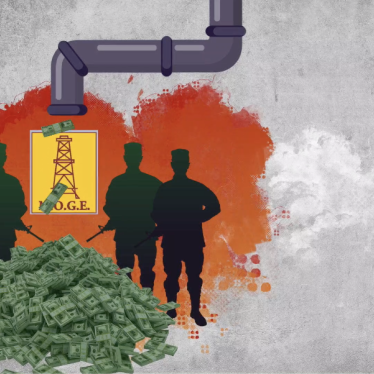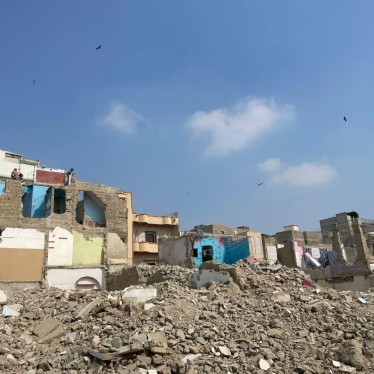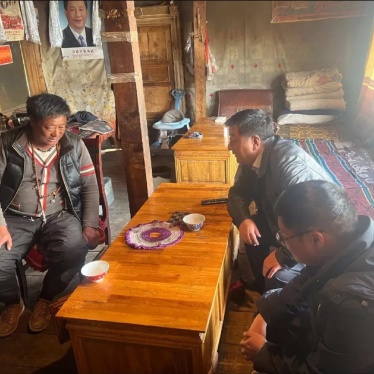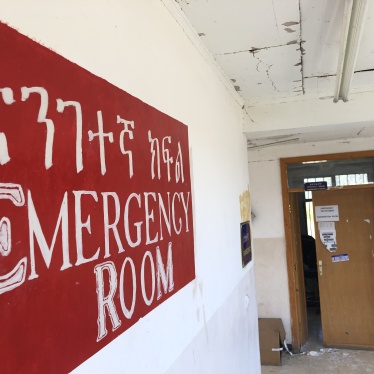Summary
Human Rights Watch welcomes the Committee’s focus on the human rights implications of recent violence in Iran. Iranians, led by women and girls, have protested against Iran’s government since the death of 22-year-old Mahsa (Jina) Amini in the custody of Iran’s abusive “morality police” on September 16, 2022.[1] The death of Mahsa followed several recent incidents of police using unlawful force against women for not complying with Iran’s compulsory hijab laws.[2]
While protests began as a response to Mahsa's death and the oppressive hijab laws, like other recent widespread protests it has transformed into broad-based grievances against repressive, ruling authorities.[3] According to the Human Rights Activists News Agency (HRANA),[4] as of September 16, the protests had spread to at least 133 cities and 129 universities as well as several secondary schools.
Iranian authorities continue their crackdown on peaceful dissent, prosecuting human rights defenders and dissidents while serious human rights violators enjoy impunity. At this dire juncture for the people of Iran, we urge the Australian government to support grassroots-led efforts centred around greater human rights and freedoms in the country, and to hold the Iranian authorities accountable for their gross human rights violations by supporting initiatives at the UN Human Rights Council.
Crackdown on Protests
Iranian authorities have ruthlessly cracked down on widespread anti-government protests with excessive and lethal force throughout Iran. Based on videos of protests, and interviews with witnesses and a security force member, Human Rights Watch documented numerous incidents of security forces unlawfully using excessive or lethal force against protesters in 13 cities across Iran.[5]
As of November 11, human rights groups are investigating the reported deaths of at least 330 people, including 50 children. Thirty-nine security forces have also reportedly been killed, according to state media.[6]
Lack of Fair Trials and Due Process
Iranian authorities have escalated their assault against the protests through dubious national security charges against detained activists and grossly unfair trials. Iran has a long history of using vaguely defined national security charges against protesters and dissidents in trials that fall grossly short of international standards.[7] Iran’s intelligence agencies and state media outlets regularly publish and promote false claims against activists and dissidents.[8]
An informal network of activists inside Iran, known as the Volunteer Committee to Follow-Up on the Situation of Detainees, said that as of October 30, in addition to mass arrests of protesters, intelligence agencies have arrested 130 human rights defenders, 38 women rights defenders, 36 political activists, 19 lawyers, and 38 journalists, the majority of whom remained in detention.[9] According to the group, authorities have also arrested 308 university students and 44 children.[10]
Torture and Risk of Death Penalty
Detainees say that the Iranian authorities have subjected them to various forms of physical and psychological torture and other ill-treatment. Two female detainees arrested during protests in Kurdistan province told Human Rights Watch that authorities tortured them, including beating them with batons, electric shocks, sexual assault, verbal assault, and threats.[11]
Iran continues to be one of the world’s leading implementers of the death penalty.[12] Iran has issued two known death sentences over the ongoing protests, and reports indicate that at least nine other people are facing charges that can carry the death penalty.[13] The Australian government should press Iran to quash these death sentences.
The Australian government should be particularly vigilant about the situation of those who are detained and those at risk of being sentenced to death. Demanding the unconditional release and ending the abusive trials of all those who have been arrested for peaceful dissent should be a key priority for Australia.
Internet Restrictions
The accurate numbers of deaths, injuries, and arrests are difficult to verify given extensive internet restrictions across the country. Since the outbreak of the protests, Iranian authorities have heavily disrupted internet access across Iran. As of September 21, they had blocked several social media platforms, including WhatsApp messaging application and Instagram, by an order of Iran’s National Security Council.[14]
Internet shutdowns violate multiple rights, including the rights to freedom of expression and access to information, and the rights to peaceful assembly and association. Officials should not use broad, indiscriminate shutdowns to curtail the flow of information, nor to harm civilians’ ability to freely assemble and express political views.[15] The Australian government and other countries should press tech companies to open tech services that Iranians need for secure communications and access to information.
Discrimination Against Women and Girls
Under Iranian law, women who appear without “proper” hijab in public, based on the judgment of the country’s abusive “morality police,” can be fined or sentenced from between 10 days to two months in prison.[16] Iran’s morality police regularly arrest women in public places. In July, police arrested a woman who had been harassed and filmed for noncompliance. She was reportedly beaten in custody and taken to the hospital for internal bleeding, before being forced to apologize on state television.[17]
Over the past five years, authorities have prosecuted several activists, including Yasman Ariani, Saba Kordafshari, Monireh Arabshahi, Mojgan Keshavarz, and Farhad Meysami for their peaceful opposition to compulsory hijab laws.[18] Prominent lawyer Nasrin Sotoudeh was arrested in 2018 shortly after she filed a case on behalf of a woman who was arrested for removing her headscarf. Authorities sentenced her to 38 years in prison and 148 lashes. Based on Iran’s penal code, if confirmed, she must serve 12 years in prison.[19]
Iranian women have been fighting against severe discrimination in law and practice for decades. Iran’s civil code provides that girls can marry at 13 and boys at age 15, as well as at younger ages if authorized by a judge. Once married, the Civil Code provides that the husband has the right to choose where they live, and he can prevent his wife from having certain jobs if he deems them against “family values.” Under the Passports Law, a woman needs her husband’s permission to obtain a passport and travel outside the country.[20]
In 2017, Human Rights Watch found that employers routinely advertise jobs for men over women, and some require written consent from husbands and fiancés, with no law to sanction them for such outright discrimination.[21] Iran’s 2021 population law passed last November introduced severe limitations on their access to sexual and reproductive rights.[22] The law outlawed sterilization and free distribution of contraceptives in the public health care system unless a pregnancy threatens a woman’s health, and further limited access to safe abortion.
Iran does not have a domestic violence law to prevent abuse, protect women, and prosecute domestic violence, despite increasing reports of horrific femicides and women risking their lives to escape abuse.[23] In many femicide cases, prosecutors, and judges often do not press for adequate penalties.[24]
Australia should call on the Iranian authorities to promptly abolish the compulsory hijab law and remove or reform other laws that deprive women of their autonomy and rights.
Harassment and Intimidation in Australia
Iranian authorities have a long history of intimidating activists and dissidents outside Iran. According to recent media reports, Iranian authorities are intimidating and surveilling members of the Iranian community in Australia.[25] Those in Australia who speak about against the Iranian government fear threats made against their family living in Iran.[26] The Australian government should examine issues of harassment and intimidation against family members of Iranian Australians as a priority.
Conclusion
International pressure is needed to end the Iranian authorities use of excessive, lethal force. Human rights defenders and victims’ relatives are echoing growing frustration at the international community’s failure to take meaningful action to address successive waves of protest killings in Iran.[27]
Australia should cooperate with other concerned governments to increase pressure on Iran and support the establishment of a United Nations-led independent inquiry into serious abuses committed during the protests and recommend avenues for holding those responsible to account.[28]
Recommendations:
Human Rights Watch recommends that the Australian government:
- Publicly support the Iranian people in their struggle against abusive policies especially those targeting women and support broader social and political rights. Australia can highlight the role of Iran-based women and young people in leading the current wave of protests. The Australian government should be particularly vigilant about the situation of those who are detained and those at risk of being sentenced to death, and demand the unconditional release and ending the abusive trials of all those who have been arrested for peaceful dissent.[29]
- At the upcoming UN Human Rights Council special session on Iran, the Australian government should support the establishment of an independent mechanism with investigative, reporting and accountability functions to address the most serious crimes under international law and other gross human rights violations committed in Iran, including in the context of successive waves of protest crackdowns.
- Impose targeted sanctions against abusive Iranian entities and individuals responsible for ongoing serious human rights violations. Designating specific units of security forces or individuals in charge of leading the crackdown against protests and telecommunication officials behind the internet shutdown sends a message that the Australian government stands in solidarity with peaceful protestors. Any sanctions should be carefully targeted to avoid overly broad application and inadvertent harm to human rights defenders, respect due process of those affected and give clear indications about what actions those designated need to take to have the sanctions lifted.
- Ensure that investigators within the Australian Federal Police (AFP) and Home Affairs tasked with investigating foreign interference also document and investigate the scale of harassment, intimidation, and surveillance of the Iranian diaspora community. Ensure that the Commander Counter Foreign Interference and Special Investigations at the AFP and the National Counter Foreign Interference Coordinator strengthen their engagement with Iranian diaspora community.
- The Australian government should increase the number of humanitarian visas for at-risk Iranians and prioritize family reunions.
---
[1] Tara Sepehri Far (Human Rights Watch), "Woman Dies in Custody of Iran's 'Morality Police'," September 16, 2022, https://www.hrw.org/news/2022/09/16/woman-dies-custody-irans-morality-police.
[2] Ibid.
[3] Ibid.
[4] “Iran: Thousands of Detained Protesters and Activists in Peril,” Human Rights Watch news release, November 3, 2022, https://www.hrw.org/news/2022/11/03/iran-thousands-detained-protesters-and-activists-peril.
[5] Ibid.
[6] HRANA English, “Daily Statistics on Iran Protests,” November 11, 2022, https://twitter.com/HRANA_English/status/1591017887589748736?s=20&t=-jmRPl4Zqh-GWbHD9AHAIA (accessed November 18, 2022).
[7] “Iran: Death Penalty for Protest-Related Charges,” Human Rights Watch news release, July 10, 2020, https://www.hrw.org/news/2020/07/10/iran-death-penalty-protest-related-charges.
[8] “Iran: Thousands of Detained Protesters and Activists in Peril,” Human Rights Watch news release, November 3, 2022, https://www.hrw.org/news/2022/11/03/iran-thousands-detained-protesters-and-activists-peril.
[9] Volunteer Committee to Follow-Up on the Situation of Detainees, “Detainee List, Oct 2020 Iran,” October 30, 2022, https://www.hrw.org/sites/default/files/media_2022/11/Detainee%20List%20Oct%202020%20Iran.pdf (accessed 8 November 2022).
[10] “Iran: Thousands of Detained Protesters and Activists in Peril,” Human Rights Watch news release, November 3, 2022, https://www.hrw.org/news/2022/11/03/iran-thousands-detained-protesters-and-activists-peril.
[11] Ibid.
[12] “Iran: Events of 2021,” Human Rights Watch World Report chapter, January 2022, https://www.hrw.org/world-report/2022/country-chapters/iran.
[13] Human Rights Watch, Iran Issues Two Known Death Sentences Over Ongoing Protests, video, November 16, 2022, https://twitter.com/hrw/status/1592646123990253569.
[14] “Iran: Security Forces Fire On, Kill Protestors” Human Rights Watch news release, October 5, 2022, https://www.hrw.org/news/2022/10/05/iran-security-forces-fire-kill-protesters.
[15] Ibid.
[16] Ibid.
[17] Tara Sepehri Far (Human Rights Watch), “Woman Dies in Custody of Iran’s ‘Morality Police’,” September 16, 2022, https://www.hrw.org/news/2022/09/16/woman-dies-custody-irans-morality-police.
[18] “Iran: Release Anti-Compulsory Hijab Activists,” Human Rights Watch news release, April 18, 2019, https://www.hrw.org/news/2019/04/18/iran-release-anti-compulsory-hijab-activists.
[19] “Iran: Harsh Sentence for Rights Lawyer Threatens Activism,” Human Rights Watch news release, March 20, 2019, https://www.hrw.org/news/2019/03/20/iran-harsh-sentence-rights-lawyer-threatens-activism; “Iran: Release Anti-Compulsory Hijab Activists,” Human Rights Watch news release, April 18, 2019, https://www.hrw.org/news/2019/04/18/iran-release-anti-compulsory-hijab-activists.
[20] Human Rights Watch, “It’s A Men’s Club”: Discrimination Against Women in Iran’s Job Market, (New York: Human Rights Watch, 2017) https://www.hrw.org/report/2017/05/25/its-mens-club/discrimination-against-women-irans-job-market.
[21] Ibid.
[22] “Iran: Population Law Violates Women’s Rights,” Human Rights Watch news release, November 10, 2021, https://www.hrw.org/news/2021/11/10/iran-population-law-violates-womens-rights.
[23] Maya Ghazi (Human Rights Watch), “Gruesome Femicide in Iran” February 11, 2022, https://www.hrw.org/news/2022/02/11/gruesome-femicide-iran; “Horrific Death of a Woman in Kurdistan Province Sparks Protests,” Human Rights Watch blog, September 15, 2022, https://www.hrw.org/blog-feed/iranian-society-under-crackdown#blog-382848.
[24] Maya Ghazi (Human Rights Watch), “Gruesome Femicide in Iran” February 11, 2022, https://www.hrw.org/news/2022/02/11/gruesome-femicide-iran.
[25] Mahmood Fazal, “How the Iranian regime is intimidating and surveilling its former citizens in Australia,” ABC News, November 5, 2022, https://www.abc.net.au/news/2022-11-05/threats-surveillance-intimidation-iran-protest/101614078.
[26] Ibid.
[27] “UN Human Rights Council must hold a special session on Iran,” Human Rights Watch news release, October 17, 2022, https://www.hrw.org/news/2022/10/17/un-human-rights-council-must-hold-special-session-iran (accessed 8 November, 2022).
[28] Ibid.
[29] “Iran: Thousands of Detained Protesters and Activists in Peril,” Human Rights Watch news release, November 3, 2022, https://www.hrw.org/news/2022/11/03/iran-thousands-detained-protesters-and-activists-peril.








